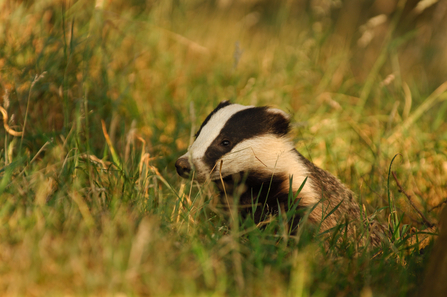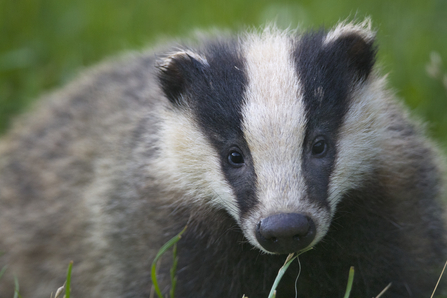
Andrew Parkinson/2020VISION

Andrew Parkinson/2020VISION
In the two years of culling in Somerset and Gloucestershire, the badger cull has been found to be repeatedly flawed in its methodology, its measures and its objectives. It has been a resounding policy failure and should be halted immediately.
Stephen Trotter, The Wildlife Trusts' Director, England, said: “We are on the side of farmers in the battle against bovine TB. This is an awful disease and I understand the emotional and financial pain it causes. I have huge sympathy for those farmers, and their families, whose businesses and lives have been brutally affected. But this is the wrong way of tackling bovine TB and we strongly disagree with this decision”.
Stephen added: “The Government’s decisions go against the scientific evidence and expert advice – and they disregard the weight of public opinion, which is against the culling of badgers. The published reviews of the pilot culls have shown them to be ‘ineffective’ and ‘inhumane’. Many people will today be infuriated, exasperated and angry about what is happening.”
It has been a resounding policy failure and should be halted immediately.

Badger © Bertie Gregory/2020VISION
"The cost of the culls has been eye-watering; the Government must explain why it sees this as a cost-effective use of tax payers’ money, especially when there are less expensive and more effective measures available to them, like vaccination.”
“Against this background, the licensing of a new cull zone in Dorset seems impossible to justify, especially given the ongoing reductions in cattle TB that have already been achieved in Dorset – and throughout the south west of England. As in Wales, the number of TB breakdowns in cattle has reduced through the implementation of stricter cattle-based measures such as movement controls and enhanced testing regimes. The Government should be applying the same approach as the Welsh Government which has led the way by adopting an evidence-based strategy to fight this awful disease – without the use of badger culling - and with considerable success”.
The Wildlife Trusts remain firmly opposed to the badger cull, and we urge the Government to rethink this misguided policy. We believe that a strategy of pursuing a comprehensive package of measures in cattle alongside badger vaccination would provide the most cost-effective way of defeating this disease. We call on the Government to implement:
- Fluctuating targets
The targets set by DEFRA and Natural England defining the number of badgers to be culled are flawed (they have been described as scientifically “rubbish” by Prof Rosie Woodroffe). With no reliable estimations of the size of badger populations in the cull zones, and cull targets reduced on an annual basis, it is impossible to know when the critical target level of 70% cull rates have been achieved. This undermines the credibility of the results and invalidates the purpose of the licensing process. This year’s they have been drastically reduced. Contractors in Somerset will be required to remove a minimum of just 55 badgers but have been authorised to cull up to 524.
- A lack of scientific methodology?
DEFRA has argued that culling must continue for the full four years to achieve ‘disease control benefits’. These benefits are not being monitored or measured and indeed, can’t be: there are no control areas and no way of separating any potential impacts of culling from impacts of other cattle measures in place, thus the effect of culling badgers cannot be assessed.
- The Perturbation Effect
If the cull fails to kill a sufficient percentage of the badger population (removing ‘too few’ badgers over an extended period) there is a high probability of perturbation and a real risk of increasing disease transmission – but it is not known what the minimum level might be in these areas. The best available evidence (gained from the Government-funded Randomised Badger Culling Trial) suggests that at least 70% of the population of badgers should be removed within a limited timeframe to reduce the risk of perturbation. In 2013, with a considerable extension to the culling period, there was an estimated reduction of 65% in Somerset and just 39% in Gloucestershire.
- Lack of veterinary support
The Independent Expert Panel set up to assess the effectiveness of the culls was quickly scrapped when it found that controlled shooting was inhumane and ineffective. Since then, the British Veterinary Association (BVA) has withdrawn its support for the method of controlled shooting, and a coalition of 27 vets wrote an open letter to Natural England requesting that they re-examine the scientific evidence before authorising culling activity this year. Natural England neglected to answer the queries and referred the vets to DEFRA.
- Success of reducing bTB in cattle in Wales, without a badger cull
According to Chief veterinary officer for Wales, Prof Christianne Glossop, incidents of bovine TB in Wales have fallen by 28%; the number of cattle culled has fallen by 45%; and 94% of Welsh herds are TB free. This has all been achieved without culling badgers. Instead, more than 5,000 badgers have now been vaccinated in Wales in four years - and all for the price of two weeks of badger culling in England.
- Cattle measures are working in the South West of England
Official DEFRA statistics illustrate that new herd incidents in Cornwall are down by 21%, in Wiltshire by 25% and in Dorset by 43%, compared to last year – and without culling badgers. The level of new breakdowns also decreased in Gloucestershire but only by 12%, and there has been an 25% increase in Somerset. (Comparison of new herd incidents in Feb 2015 versus Feb 2014.)
- Why Dorset?
Official DEFRA statistics show a decrease (by 37%) in the number of cattle slaughtered in Dorset over the last three years. New herd incidents in Dorset have fallen by 20% (74 in Jan-May 2014, compared to 59 in Jan-May 2015) while incidents in Somerset have risen by 10% over the same period.
- The Government has disregarded the views of hundreds of thousands of people across the UK, not to mention the outcomes of two free votes in parliament.
- The independent Expert Panel set up by Government deemed the method of controlled shooting to be ‘inhumane’ and the British Veterinary Association has since withdrawn its support for this method of culling.
- In the first year, the culls cost an alarming £5,200 per dead badger. With cage trapping now the main method employed for culling, it has been shown repeatedly that it is more effective and cheaper to vaccinate badgers against the disease. Based on research from The Wildlife Trusts’ own vaccination programmes in 2014, the average cost per badger vaccinated was £293.
Adam Cormack (Senior Communications Manager)
Office: 01636 670063
Mobile: 07824 846204
Email: acormack@wildlifetrusts.org
Anna Guthrie (Media & PR Manager)
Office: 01636 670075
Mobile: 07887 754659
Email: aguthrie@wildlifetrusts.org